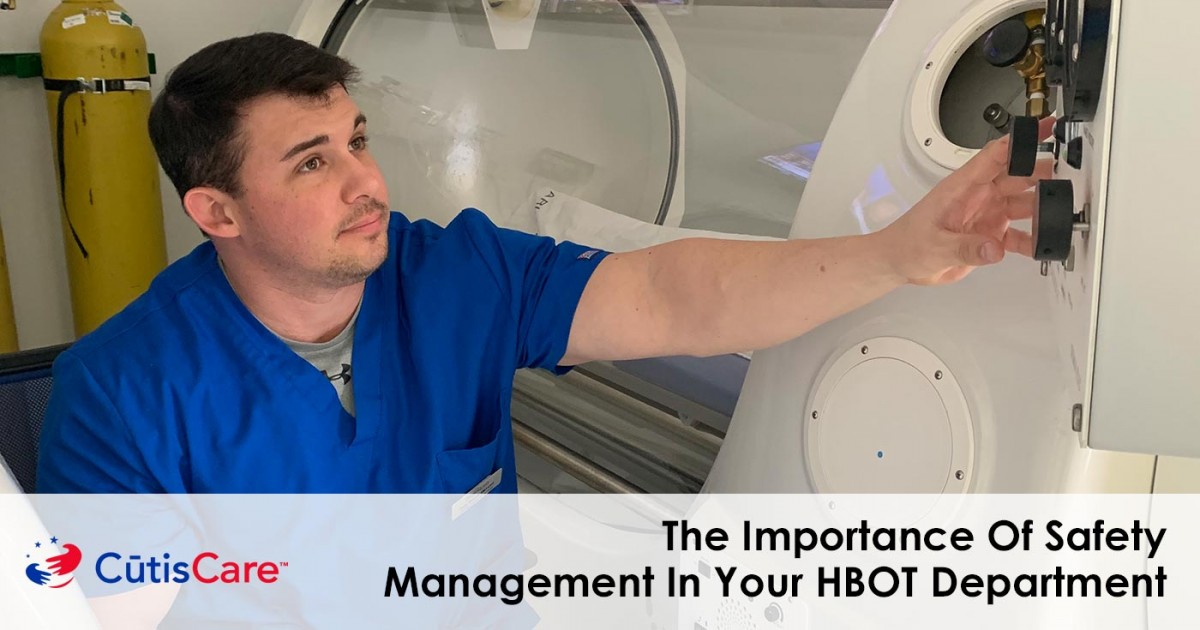The Importance Of Safety Management In Your HBOT Department

The Importance Of Safety Management In Your HBOT Department
Reading Time: 3 minutes
The growth of hyperbaric medical facilities throughout the country and the globe has brought with it, an increase in demand for qualified professionals to uphold the best in patient safety and standards. As more and more medical facilities are incorporating Hyperbaric Oxygen Therapy (HBOT) departments into their patient services, the need to ensure that staff are properly trained in HBOT best practices becomes all the more imperative.
In this guide, we’re going to provide you a detailed overview of the essential safety management elements all facilities must implement to optimize standards and practices for patients and staff alike.
Key Safety Measures
Each person working in the HBOT department who has access to and operates the chamber must clearly understand the possibility for accidents, how to prevent those dangers, and the way to leverage that knowledge to ensure safe and secure operation of the chamber and its associated equipment.
The key competencies involved in safety management are the strength of the pressure chamber, proper gas handling, fire safety, decompression security, and proper training. All electrical devices in patient contact must be fully safeguarded against any electrical hazards for patients in compliance with current medical rules applicable to HBOT chambers.
The rooms provided for patients to prepare for the chamber should be outfitted for easy access, especially when these individuals are under intensive care for impairments such as traumatic brain injuries or similar. As such, handrails must be securely affixed to the walls of changing rooms and all primary patient areas, including the bathrooms, hallways, and rooms housing any chamber unit. Likewise, keys or other unlocking devices to patient restrooms should be readily accessible to authorized, trained staff to assist in the event of an emergency.
Preparing for the Chamber
All patient rooms and bathrooms must be assigned call light cords a maximum of 6 inches from the floor to ensure ease of access in the event of an emergency. Before being permitted to enter the systemic unit, patients must undergo control assessments to ensure their medical condition is such that the HBOT chamber will not pose a threat, especially if they are already wearing medical devices or have dressed wounds.
There should be safety policies in place with regards to the proper clothing patients should wear or remove before entering the chamber. Staff should be trained to inspect any personal accouterments and bedding equipment as required. Besides this, designated areas for storage of patient valuables should be made available.
Hazard Prevention
In order to remove the possibility of potential hazards, particularly as many of the patients approved for HBOT treatment are under intensive care and necessitate the use of special transport between the hospital and HBOT facility, the two must be well connected.
The HBOT department must be free of any fall, trip, or slip hazards that pose a risk of injury to patients. In addition, staff must be adequately trained in accessing and controlling all equipment related to the operation of the HBOT department. For instance, if patients require transfer assistance through the use of slide boards and/or Hoyer boards, all individuals employed in the HBOT department must be trained in performing these transfers correctly and safely.
Core Competencies
All staff trained in helping patients prepare for and the operation of the HBOT machine must have current HBOT credentialing and competencies on file for all associated equipment. Individuals working in the HBOT department must be equipped to prepare and inform patients regarding Hyperbaric Oxygen Therapy. These competencies include, but are not limited to, the ability to assist and transfer patients according to department policy, whether through the use of slide boards/Hoyer boards or otherwise.
HBOT department staff must also be equipped to assist patients in getting ready for treatment, including answering any queries that might be posed. Staff must administer HBOT as advised by the provider, including, but not limited to, supervising and operating the chamber, surveilling patient reactions while in the chamber, and making any required alterations to ascertain the patient’s wellbeing and secure operation of the equipment.
Staff must be competent in entering all related data as needed for daily chamber treatments and wound care appointments, maintaining comprehensive and precise patient records regarding treatment, and including any images on file.
It is of the utmost importance to ensure your staff is fully certified and competent to handle all the aforementioned responsibilities and more. Here at CūtisCare, we partner with healthcare providers around the nation in the management of wound care and Hyperbaric Oxygen services to ensure each physician and staff member is in full compliance with modern industry standards and regulations for HBOT departments.
Call CūtisCare at (561) 617-7067 to find out how we can walk alongside your facility to ensure regulatory compliance and safety management for your HBOT department.
